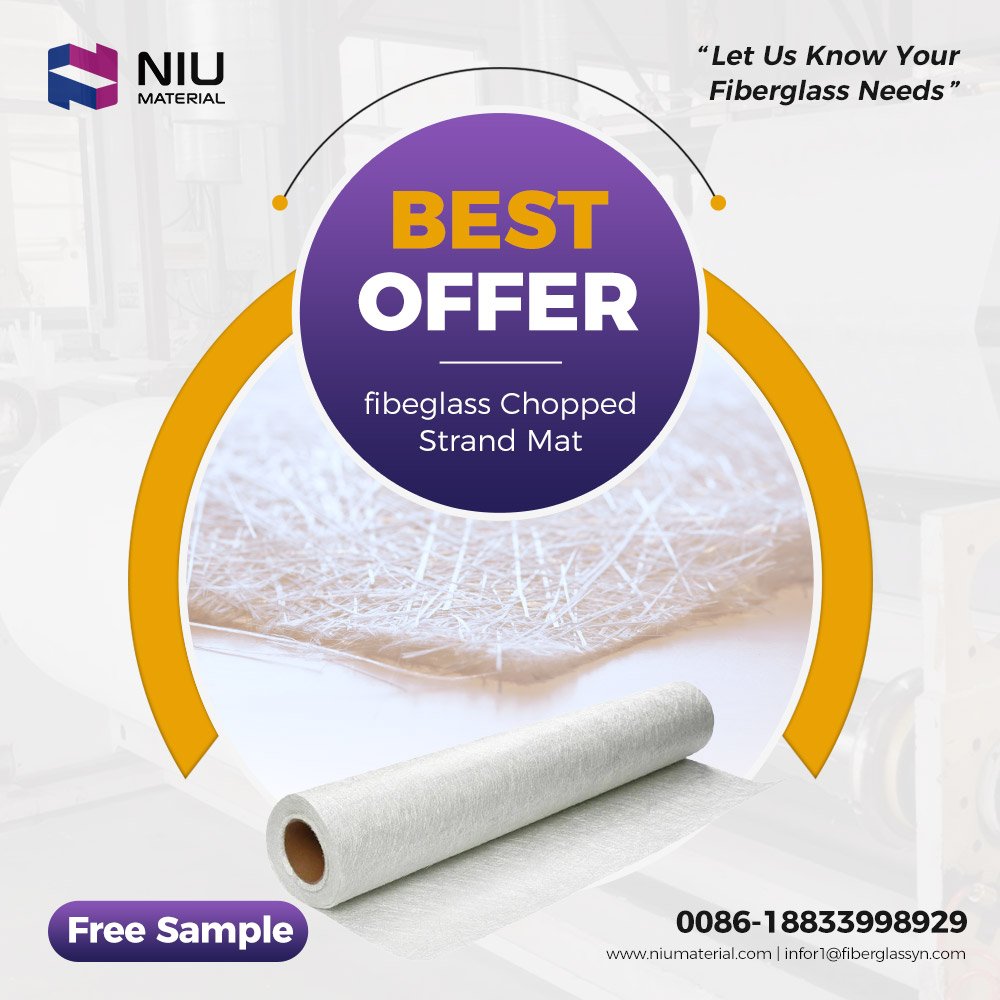- infor1@fiberglassyn.com
- +86-13933702587

Fiberglass chopped strand mat materials play a crucial role in various industries, from manufacturing to engineering. If you find yourself curious about this versatile material, you’ve come to the right place. In this comprehensive guide, we’ll delve into the depths of Fiberglass chopped strand mat, answering ten essential questions that will broaden your understanding. So, let’s embark on this journey of discovery together.
Fiberglass chopped strand mat, commonly known as chopped strand mat (CSM), is a non-woven reinforcement material used in the manufacturing of composite materials. It plays a crucial role in reinforcing various products, providing strength and durability. Fiberglass chopped strand mat roll is composed of randomly oriented chopped glass fibers held together by a binder or stitching. This construction allows for excellent conformability to complex shapes, making it a versatile material in composite applications.
Fiberglass chopped strand mat is primarily made of glass fibers. These fibers are typically manufactured from molten glass that is drawn into thin strands. These strands are then chopped into short lengths and distributed randomly to form the mat. The fibers are usually bound together with a binder, which helps maintain the mat’s shape and integrity. The choice of glass and the binder material can vary depending on the specific application and performance requirements.
Fiberglass chopped strand mat offers several advantages that make it a popular choice in the composite industry. Firstly, its random fiber orientation provides isotropic strength, meaning it offers strength in multiple directions. This property makes it ideal for reinforcing parts with complex shapes.
Another key advantage is its cost-effectiveness. Fiberglass chopped mat is generally more economical than other reinforcement materials, making it a preferred choice for large-scale manufacturing processes.
The mat’s ability to conform to molds and surfaces without the need for complex tooling is another noteworthy advantage. This simplifies the manufacturing process and allows for the production of a wide range of components with varying geometries.
Additionally, chop strand mat provides good resin absorption, ensuring a strong bond between the fibers and the matrix material. This promotes enhanced mechanical properties in the final composite product.
Fiberglass chopped strand mat is widely used in various fields, and its main uses cover many aspects of composite material manufacturing. The material is made up of randomly distributed chopped glass fibers held together by adhesives or stitching. The following are the main uses for chopped braided fiberglass:
Chopped braid is widely used in shipbuilding to increase the strength and stiffness of the hull. It adapts to the curves and shapes of the hull, providing excellent structural support and making the boat stronger and more durable.
In the automotive manufacturing industry, chopped braid is used to produce body parts such as body panels and hoods. Its excellent shape adaptability makes it an ideal choice for manufacturing parts with complex shapes.
Wind turbine blades: Wind turbine blades often use chopped woven fiberglass to increase the strength and rigidity of the blade. This helps resist wind pressure and extends the life of the blades.
In the construction sector, chopped woven fiberglass is used to manufacture a variety of building materials such as pipes, panels and decorative elements. Its ease of handling and cost-effectiveness make it a commonly used material in the construction industry.
Due to its strong reinforcing properties, chopped braid is widely used in the manufacturing of storage tanks and vessels, ensuring that these structures are strong enough to withstand pressure and loads.
Overall, chopped woven fiberglass is a versatile reinforcement material that plays a key role in multiple fields and provides a reliable solution for composite manufacturing.
Using a fiberglass mat involves several steps to ensure proper reinforcement in the composite product. The general process includes preparing the mold, cutting the mat to the desired shape and size, layering the mat in the mold, and applying resin to saturate the fibers.
Ensure that the mold is clean and properly coated with a release agent to facilitate easy removal of the cured composite.
Cut the Fiberglass chopped strand mat to the required dimensions using sharp scissors or a utility knife. Take into account the shape and contours of the mold.
Wind turbine blades: Wind turbine blades often use chopped woven fiberglass to increase the strength and rigidity of the blade. This helps resist wind pressure and extends the life of the blades.
Place the cut mat into the mold, ensuring it conforms to the shape without wrinkles or air pockets. For thicker or stronger parts, multiple layers of mat can be applied.
Mix the appropriate resin according to the manufacturer’s instructions. Using a brush or roller, apply the resin to saturate the mat thoroughly. Ensure that the resin penetrates the fibers for a strong bond.
Allow the resin to cure and harden, following the recommended curing time and temperature. Once cured, the composite part can be removed from the mold.
Cutting a fiberglass mat requires precision to achieve the desired shape without fraying the edges. Follow these steps for clean and accurate cuts:
Use a marker or pencil to mark the cut line on the chopped strand fiberglass mat. Ensure that the markings are clear and visible.
Place a straight edge or template along the marked line to guide the cutting tool. This helps maintain straight and accurate cuts.
A sharp utility knife or scissors is suitable for cutting chopped strand mat 450 gsm. Ensure that the cutting tool is sharp to prevent fraying of the fibers.
Apply even pressure along the cut line, allowing the cutting tool to smoothly penetrate the mat. Avoid jagged or uneven cuts by maintaining a consistent cutting motion.
Once the main cuts are complete, trim any uneven edges or excess material to achieve the final desired shape.
The weight of fiberglass chopped strand matting can vary depending on its thickness and density. Typically, fiberglass chopped strand mat is measured in ounces per square yard (oz/yd²) in the imperial system or grams per square meter (g/m²) in the metric system. Common weights for fiberglass chopped strand mat range from 1.5 oz/yd² to 3.0 oz/yd² (50 g/m² to 100 g/m²) for general-purpose applications. For more robust or heavy-duty applications, higher-weight mats may be used.
The thickness of fiberglass chopped strand mat can also vary based on the intended application. Fiberglass chopped strand mat is available in a range of thicknesses, typically measured in millimeters (mm) or mils (1 mil = 0.0254 mm). Common thicknesses for fiber glass mat are between 1.5 mm to 3.0 mm (60 mils to 120 mils). The choice of thickness depends on the structural requirements of the final composite product.
The selection of the best resin for e glass chopped strand mat depends on the specific application and desired properties of the composite. Polyester, epoxy, and vinylester resins are commonly used with fiberglass chopped strand mat emulsion, each offering unique characteristics:
The best resin choice depends on factors such as the intended use, environmental conditions, and desired mechanical properties of the composite product.
Coating a fiberglass braid with resin is one of the key steps in the composite manufacturing process. Here are the steps on how to do it:
Mix the resin and catalyst evenly, ensuring accurate measurements to achieve the desired cure characteristics.
Use a brush or roller to apply the mixed resin to the fiberglass braid. Start in the center and work your way outward to ensure even coverage.
Make sure the resin completely wets the fibers. Pay attention to where there may be thicker areas and add additional resin if necessary to ensure a strong bond between the fibers and resin.
Use a roller to gently roll the soaked braid to expel air bubbles and ensure good adhesion between fibers and resin.
If using multiple layers of braid, repeat the process for each layer. Make sure each layer is well wetted and take care to maintain proper bonding between layers.
After you have finished applying the resin, wait for the resin to cure and harden according to the manufacturer’s recommendations. Make sure to follow the correct temperature and time requirements during this process.
The above steps ensure that the resin is fully penetrated and firmly bonded with the fibers, resulting in a composite material with superior strength and durability. This process is essential for making strong, lightweight and complex-shaped components.
In summary, understanding fiberglass chopped strand mat materials is critical for anyone involved in manufacturing, engineering, or working with composite materials. From its composition to its applications and the complexities of using it, the knowledge provided in this guide is a valuable resource. Whether you are a seasoned professional or new to the world of composites, the versatility and reliability of chopped strand mat have made it a cornerstone of the materials science field.

If you have any questions
Please contact us for free consultation and product quotation
Table of Contents Add a header to begin generating the table of contents Introduce Concrete is the backbone of construction—but its inherent brittleness, vulnerability to
Table of Contents Add a header to begin generating the table of contents Introduce A roof is more than just a top layer of a
You can leave your needs and contact information~and We can provide you with usage suggestions + product suitability analysis + free sample delivery!
Leave us your interest and contact information, and we’ll send you detailed information for your reference!
You can leave the specifications and contact information you need~ Our technicians will immediately organize the exclusive information for you and send it to your email!
You can leave your contact information here, and we will send you detailed specifications and application cases to make your purchase clearer~